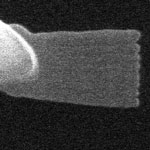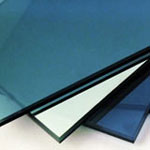Showing Spotlights 2009 - 2016 of 2855 in category All (newest first):
 In today's addition to our Application Note series we are looking at the future of electronics and the implications for research instrumentation. We are showing two examples of atomic force microscope (AFM) applications employed in this research. Current CMOS (complementary metal-oxide-semiconductor) technology used for making integrated circuits is constantly being scaled down. These devices will reach their ultimate physical limits in 10 to 15 years. As chip structures - which currently already have reached nanoscale dimensions - continue to shrink below the 20 nanometer mark, ever more complex challenges arise and scaling appears not to be economically feasible any more. And below 10 nm, the fundamental physical limits of CMOS technology will be reached. Researchers are therefore exploring novel concepts for future nanoelectronic devices.
In today's addition to our Application Note series we are looking at the future of electronics and the implications for research instrumentation. We are showing two examples of atomic force microscope (AFM) applications employed in this research. Current CMOS (complementary metal-oxide-semiconductor) technology used for making integrated circuits is constantly being scaled down. These devices will reach their ultimate physical limits in 10 to 15 years. As chip structures - which currently already have reached nanoscale dimensions - continue to shrink below the 20 nanometer mark, ever more complex challenges arise and scaling appears not to be economically feasible any more. And below 10 nm, the fundamental physical limits of CMOS technology will be reached. Researchers are therefore exploring novel concepts for future nanoelectronic devices.
Nov 2nd, 2009
 Traditional techniques in cell biology involve chemical or pharmaceutical treatments of entire cells; however, in many cases it would be advantageous to target a single organelle or other structure within a cell without damaging overall cell structure. If scientists could inject a drug into a chosen organelle within the cell, or even destroy, extract or isolate the whole organelle without significantly harming the cell itself, new insight could be gained into the inner workings of the cell. In recent years, techniques have been developed which allow the manipulation of the individual nanoscale structures within biological cells. This manipulation, or 'nanosurgery', has the potential to provide new insight into the internal structure and dynamics of cells. Nanosurgical methods have been developed to target the cell's internal organelles, the cell membrane, and the structural protein filaments within the cell.
Traditional techniques in cell biology involve chemical or pharmaceutical treatments of entire cells; however, in many cases it would be advantageous to target a single organelle or other structure within a cell without damaging overall cell structure. If scientists could inject a drug into a chosen organelle within the cell, or even destroy, extract or isolate the whole organelle without significantly harming the cell itself, new insight could be gained into the inner workings of the cell. In recent years, techniques have been developed which allow the manipulation of the individual nanoscale structures within biological cells. This manipulation, or 'nanosurgery', has the potential to provide new insight into the internal structure and dynamics of cells. Nanosurgical methods have been developed to target the cell's internal organelles, the cell membrane, and the structural protein filaments within the cell.
Oct 30th, 2009
 Due to their unique structural and electrical properties, carbon nanotubes have been extensively investigated as promising catalyst supports to improve the efficiency of direct ethanol/methanol fuel cells. CNTs have a significantly higher electronic conductivity and an extremely higher specific surface area in comparison with the most widely-used Vulcan XC-72R carbon support. Several approaches, such as electrochemical reduction, electroless deposition, spontaneous reduction, sonochemical technique, microwave-heated polyol process, and nanoparticle decoration on chemically oxidized nanotube sidewalls, have been reported to form CNT-supported platinum catalysts. Some remarkable progress has been made in synthesis techniques; however, pioneering breakthroughs have not been made yet in terms of cost-effectiveness catalyst activity, durability, and chemical-electrochemical stability. Nanotechnology researchers in the U.S. have now discovered that platinum nanoparticles selectively grow on carbon nanotubes in accordance with single-stranded DNA locations.
Due to their unique structural and electrical properties, carbon nanotubes have been extensively investigated as promising catalyst supports to improve the efficiency of direct ethanol/methanol fuel cells. CNTs have a significantly higher electronic conductivity and an extremely higher specific surface area in comparison with the most widely-used Vulcan XC-72R carbon support. Several approaches, such as electrochemical reduction, electroless deposition, spontaneous reduction, sonochemical technique, microwave-heated polyol process, and nanoparticle decoration on chemically oxidized nanotube sidewalls, have been reported to form CNT-supported platinum catalysts. Some remarkable progress has been made in synthesis techniques; however, pioneering breakthroughs have not been made yet in terms of cost-effectiveness catalyst activity, durability, and chemical-electrochemical stability. Nanotechnology researchers in the U.S. have now discovered that platinum nanoparticles selectively grow on carbon nanotubes in accordance with single-stranded DNA locations.
Oct 28th, 2009
 From an energy savings point of view, the use of smart windows - electrically switchable glass which controls the amount of light passing through when voltage is applied - can save costs for heating, air-conditioning and lighting and avoid the cost of installing and maintaining motorized light screens or blinds or curtains. A disadvantage is of course the fact that the smart windows themselves need to draw energy in order to do their job. Now, researchers have developed a self-powered, fast-switching smart window that doubles as a solar cell, using sun light to power its chromic behavior and making the case for energy savings even more compelling. By employing a patterned tungsten oxide/platinum electrochromic electrode and a dye-sensitized titanium dioxide nanoparticle photoanode, the self-powered photovoltachromic cell (PVCC) which exhibits distinct electrochromic characteristics of a fast switching rate and tunable transmittance under illumination. The novel device has both photoelectrochromic and photovoltaic characteristics.
From an energy savings point of view, the use of smart windows - electrically switchable glass which controls the amount of light passing through when voltage is applied - can save costs for heating, air-conditioning and lighting and avoid the cost of installing and maintaining motorized light screens or blinds or curtains. A disadvantage is of course the fact that the smart windows themselves need to draw energy in order to do their job. Now, researchers have developed a self-powered, fast-switching smart window that doubles as a solar cell, using sun light to power its chromic behavior and making the case for energy savings even more compelling. By employing a patterned tungsten oxide/platinum electrochromic electrode and a dye-sensitized titanium dioxide nanoparticle photoanode, the self-powered photovoltachromic cell (PVCC) which exhibits distinct electrochromic characteristics of a fast switching rate and tunable transmittance under illumination. The novel device has both photoelectrochromic and photovoltaic characteristics.
Oct 27th, 2009
 A couple of years ago we reported on applications of nanotechnology-based processes to the restoration and preservation of priceless artwork. Researchers have shown that nanodispersions of solids, micelle solutions, gels and microemulsions offer new reliable ways to restore and preserve works of art by merging together the main features and properties of soft-matter and hard-matter systems, allowing the synthesis of systems specifically tailored for the works of art to fight the deterioration processes which threaten many priceless masterpieces. Researchers at the University of Florence, who have been leading efforts to apply nanoparticle-based cleaning agents for artwork, have now further developed their work by exploring the design of novel systems containing low amounts of volatile oils as low-impact cleaning tools for the removal of aged polymeric coatings from the surface of paintings.
A couple of years ago we reported on applications of nanotechnology-based processes to the restoration and preservation of priceless artwork. Researchers have shown that nanodispersions of solids, micelle solutions, gels and microemulsions offer new reliable ways to restore and preserve works of art by merging together the main features and properties of soft-matter and hard-matter systems, allowing the synthesis of systems specifically tailored for the works of art to fight the deterioration processes which threaten many priceless masterpieces. Researchers at the University of Florence, who have been leading efforts to apply nanoparticle-based cleaning agents for artwork, have now further developed their work by exploring the design of novel systems containing low amounts of volatile oils as low-impact cleaning tools for the removal of aged polymeric coatings from the surface of paintings.
Oct 26th, 2009
 Eric Drexler replies to yesterday's Spotlight on Feynman and nanotechnology. 'Neither Feynman nor the vision of molecular manufacturing created the fields that have joined to become 'nanotechnology', nor did they provide the concrete scientific opportunities and technological applications that drive it forward. However, what set nanotechnology on its path to prominence was not a sudden realization by the public and politicians that new molecules and nanostructures have a host of applications in materials, sensors, and so on. It was, and is, the promise of revolutionary advances in atomically precise manufacturing, advances that will build on the technology platform now emerging from nanotechnology research.'
Eric Drexler replies to yesterday's Spotlight on Feynman and nanotechnology. 'Neither Feynman nor the vision of molecular manufacturing created the fields that have joined to become 'nanotechnology', nor did they provide the concrete scientific opportunities and technological applications that drive it forward. However, what set nanotechnology on its path to prominence was not a sudden realization by the public and politicians that new molecules and nanostructures have a host of applications in materials, sensors, and so on. It was, and is, the promise of revolutionary advances in atomically precise manufacturing, advances that will build on the technology platform now emerging from nanotechnology research.'
Oct 23rd, 2009
 In December 2009 we will receive a series of reminders of the fiftieth anniversary of Richard Feynman's noted talk, 'There's Plenty of Room at the Bottom'. As commentaries appear in scientific journals, the nanotechnology community will have multiple opportunities to think about the role of Feynman's talk in the history of nanotechnology. Feynman's 1959 talk has been widely hailed as the origin of nanotechnology. It is a comprehensive vision of controlling matter at the nanoscale, including controlling individual atoms. However, at this point, there are two very different views of the role of Feynman's talk in the history of nanotechnology: 1. Everybody knows that Feynman's 'Plenty of Room' is the origin of nanotech. 2. The emergence of nanotech had little to do with Feynman's talk.
In December 2009 we will receive a series of reminders of the fiftieth anniversary of Richard Feynman's noted talk, 'There's Plenty of Room at the Bottom'. As commentaries appear in scientific journals, the nanotechnology community will have multiple opportunities to think about the role of Feynman's talk in the history of nanotechnology. Feynman's 1959 talk has been widely hailed as the origin of nanotechnology. It is a comprehensive vision of controlling matter at the nanoscale, including controlling individual atoms. However, at this point, there are two very different views of the role of Feynman's talk in the history of nanotechnology: 1. Everybody knows that Feynman's 'Plenty of Room' is the origin of nanotech. 2. The emergence of nanotech had little to do with Feynman's talk.
Oct 22nd, 2009
 Nanotechnologies are opening vast new opportunities for scientists, engineers and entrepreneurs to participate in solving some of the major problems facing mankind today. But the road from idea to commercially viable product or process is long. Especially when it comes to nanotech innovations, the research and development phase tends to be relatively lengthy. To help potential nanotechnology start-up founders with shaping their plans, Nanowerk, the leading nanotechnology information service, and Nanostart, the world's leading nanotechnology venture capital company, have teamed up to provide this useful guide which particularly addresses the funding aspects of nanotechnology start-ups, along with answers to some of the most commonly asked questions.
Nanotechnologies are opening vast new opportunities for scientists, engineers and entrepreneurs to participate in solving some of the major problems facing mankind today. But the road from idea to commercially viable product or process is long. Especially when it comes to nanotech innovations, the research and development phase tends to be relatively lengthy. To help potential nanotechnology start-up founders with shaping their plans, Nanowerk, the leading nanotechnology information service, and Nanostart, the world's leading nanotechnology venture capital company, have teamed up to provide this useful guide which particularly addresses the funding aspects of nanotechnology start-ups, along with answers to some of the most commonly asked questions.
Oct 21st, 2009
 In today's addition to our Application Note series we are looking at the future of electronics and the implications for research instrumentation. We are showing two examples of atomic force microscope (AFM) applications employed in this research. Current CMOS (complementary metal-oxide-semiconductor) technology used for making integrated circuits is constantly being scaled down. These devices will reach their ultimate physical limits in 10 to 15 years. As chip structures - which currently already have reached nanoscale dimensions - continue to shrink below the 20 nanometer mark, ever more complex challenges arise and scaling appears not to be economically feasible any more. And below 10 nm, the fundamental physical limits of CMOS technology will be reached. Researchers are therefore exploring novel concepts for future nanoelectronic devices.
In today's addition to our Application Note series we are looking at the future of electronics and the implications for research instrumentation. We are showing two examples of atomic force microscope (AFM) applications employed in this research. Current CMOS (complementary metal-oxide-semiconductor) technology used for making integrated circuits is constantly being scaled down. These devices will reach their ultimate physical limits in 10 to 15 years. As chip structures - which currently already have reached nanoscale dimensions - continue to shrink below the 20 nanometer mark, ever more complex challenges arise and scaling appears not to be economically feasible any more. And below 10 nm, the fundamental physical limits of CMOS technology will be reached. Researchers are therefore exploring novel concepts for future nanoelectronic devices. 
 Subscribe to our Nanotechnology Spotlight feed
Subscribe to our Nanotechnology Spotlight feed





